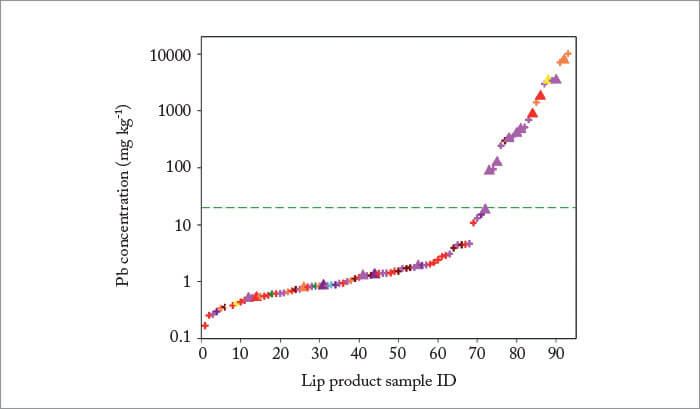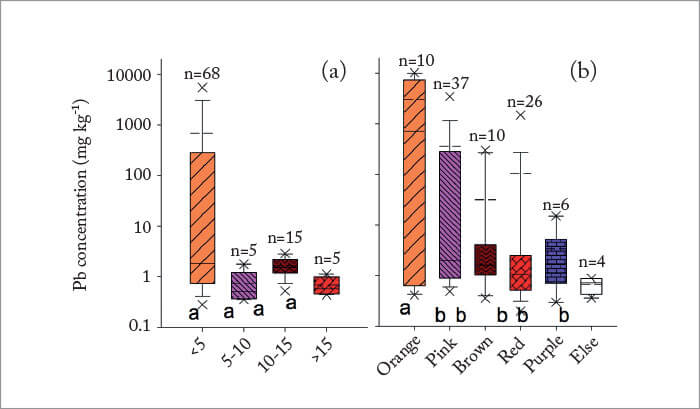After reports of high lead levels in Chinese lip products, a research group at the State Key Laboratory of Pollution Control and Resource Reuse, Nanjing University (Hongbo Li, Lena Ma, and PhD candidate Di Zhao) carried out a study into the concentrations of lead in popular cosmetics – and whether they pose a threat to lovers of lippy. “To accurately assess the health risks of lead in lip products, understanding lead bioavailability – the fraction of lead absorbed into the bloodstream following oral ingestion – is essential,” says Hongbo Li. “Until recently, there were no systematic studies available, with previous studies (1)(2)(3) focusing only on total lead concentrations in lip products without considering the bioavailability.” The research group had been focusing primarily on the bioavailability of contaminants in various matrices – including soil, dust, and food – following oral ingestion by humans, so lip products were an obvious progression.
The group purchased 93 lip products (75 lipsticks and 18 lip glosses) in different colors and at varying price points from retail stores and online. The total concentrations of seven metals (cobalt, cadmium, arsenic, nickel, chromium, zinc, and lead) in all lip products were determined using inductively coupled plasma mass spectrometry (ICP-MS, NexION 300X, Perkin Elmer) following digestion of lip products with repeated additions of concentrated HNO3 and H2O2. “To determine the relative bioavailability of lead, we selected 15 samples with relatively high lead (87–10185 mg/kg), and fed these to mice via their diet for an exposure period of 10 days, using lead accumulation in the femur as the biomarker of exposure,” Li says. The femurs were then freeze-dried and analyzed for lead concentration using ICP-MS (USEPA Method 3050B). “Based on this information, we calculated the lead intake via lip products for women and assessed its contribution to overall daily lead exposure, taking into account lead intake from other possible pathways.” Ingestion of the 15 lip products contributed 5.4–68 percent of the aggregate lead exposure for women depending on lead concentration; lip products with lead at concentrations over 1800 mg/kg contributed more than 30 percent, while ingestion of samples with lead concentrations under 500 mg/kg contributed less than 10 percent.

To identify the sources of lead in lip products, the two samples with the highest lead concentration were analyzed by X-ray absorption near-edge structure (XANES) spectroscopy at the lead LIII-edge. There was a close agreement in spectra between lead in the lip products and lead chromate, suggesting the source of lead from the addition of lead chromate. The researchers found that most lip products contained lead levels below the US Food and Drug Administration (FDA) threshold of 20 mg/kg (see Figure 1) – but that with some cheap lip products, you get what you pay for (see Figure 2A). “In general, most lip products are safe to use,” says Li. “However, cheap lipsticks (under 5 USD) tended to have high lead levels – with some containing hexavalent chromium, another carcinogen.” Finally, orange and pink products contained higher lead concentrations than brown, red, or purple products (see Figure 2B).

References
- NM Hepp et al, “Determination of total lead in lipstick: development and validation of a microwave-assisted digestion, inductively coupled plasma-mass spectrometric method”, J Cosmet Sci, 60, 405–414 (2009). NM Hepp, “Determination of total lead in 400 lipsticks on the U.S. market using a validated microwave-assisted digestion, inductively coupled plasma-mass spectrometric method”, J Cosmet Sci, 63, 159–176 (2012). S Lui et al, “Concentrations and potential health risks of metals in lip products”, Environ Health Perspect, 121, 705–710 (2013).




